What’s hydrozoning? It’s grouping plants with similar water needs. You put those plants next to each other, or you put them on the same irrigation line. And I haven’t always done it — to my great irritation, and to my plants’ hardship.
Here are three examples of times that I haven’t grouped plants in my food garden well, along with how I’ve corrected or mitigated the mistakes. Maybe they can help you design the plantings and irrigation in your yard better.
Cherries with avocados
A couple years ago, I planted two cherry trees (Lapins and Royal Crimson) near some avocado trees. (See the photo above.) Because of the proximity of the trees, I just added the cherries to the irrigation line of the avocados. The main problem with this was during the winter when the cherry trees were leafless and needing no water while the avocados still had a full canopy and sometimes needed water when the rains were too far apart.
It is not ideal to have deciduous fruit trees on the same irrigation line (schedule/station/valve) as evergreen trees. In order to keep both types of trees healthy you either overwater the deciduous fruit trees or underwater the evergreen fruit trees. I had chosen to overwater the cherries in order to keep the avocados happy. But finally, last year I corrected my mistake by running a long poly tube to connect the cherries to the irrigation line that my other deciduous fruit trees are on, thereby taking them off the avocado line.
An alternative correction in this situation would have been to insert a shutoff valve into the line going to the cherries, which I could turn off just for the winter.
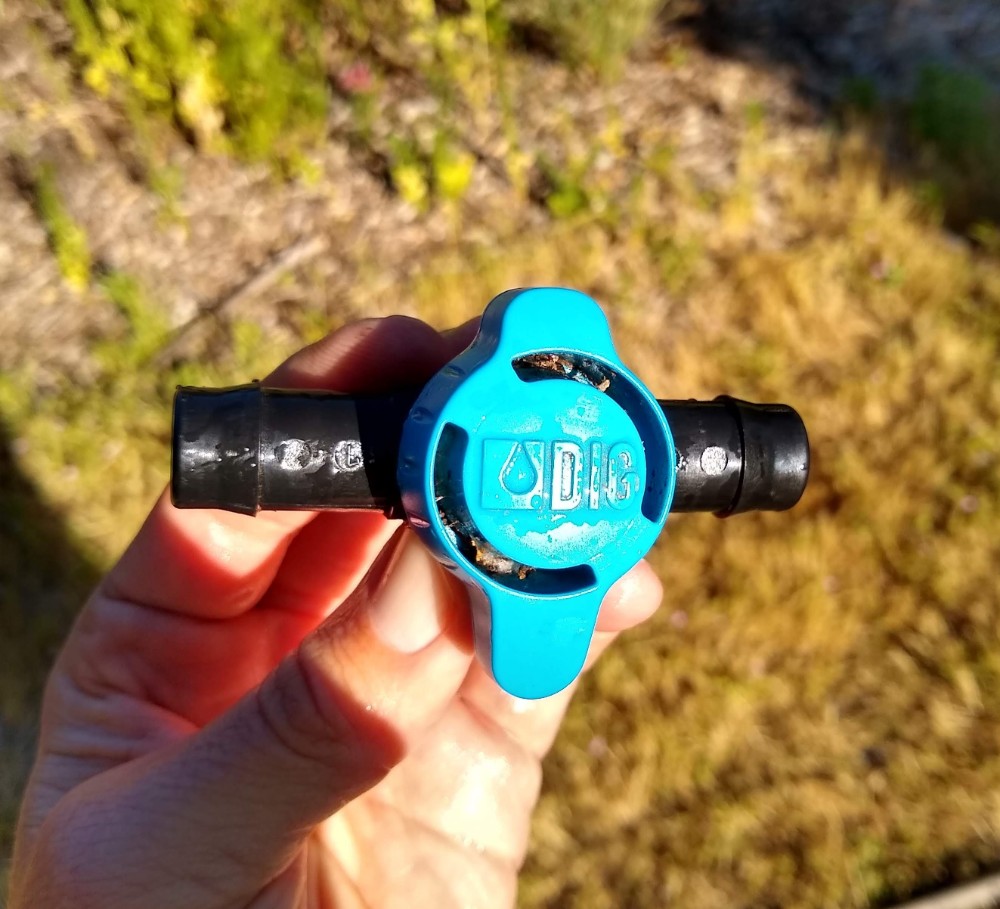
Citrus with avocados
I did exactly this on an irrigation line along my driveway where I have both avocados and citrus trees. The water needs of these two types of trees are similar, both being evergreen, but occasionally the avocados need some extra water during heat waves. With the added shutoff valve, I’m able to give them that while not wasting water on the citrus trees.
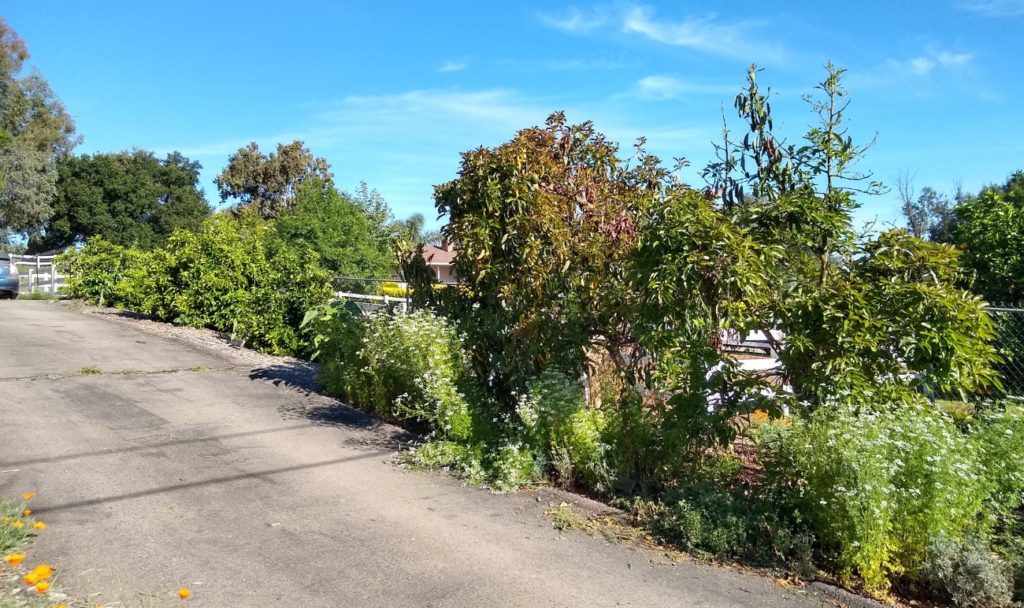
You can add shutoff valves to the sprinklers or drip lines of individual trees, or you can insert one in the main poly tube between groups of trees. In this case, I added one shutoff valve between the avocados and citrus. (The line runs up the driveway so the citrus trees are “behind” the avocados.)
Blueberries with vegetables
I planted my blueberries within my vegetable garden so they’re all on the same irrigation line.
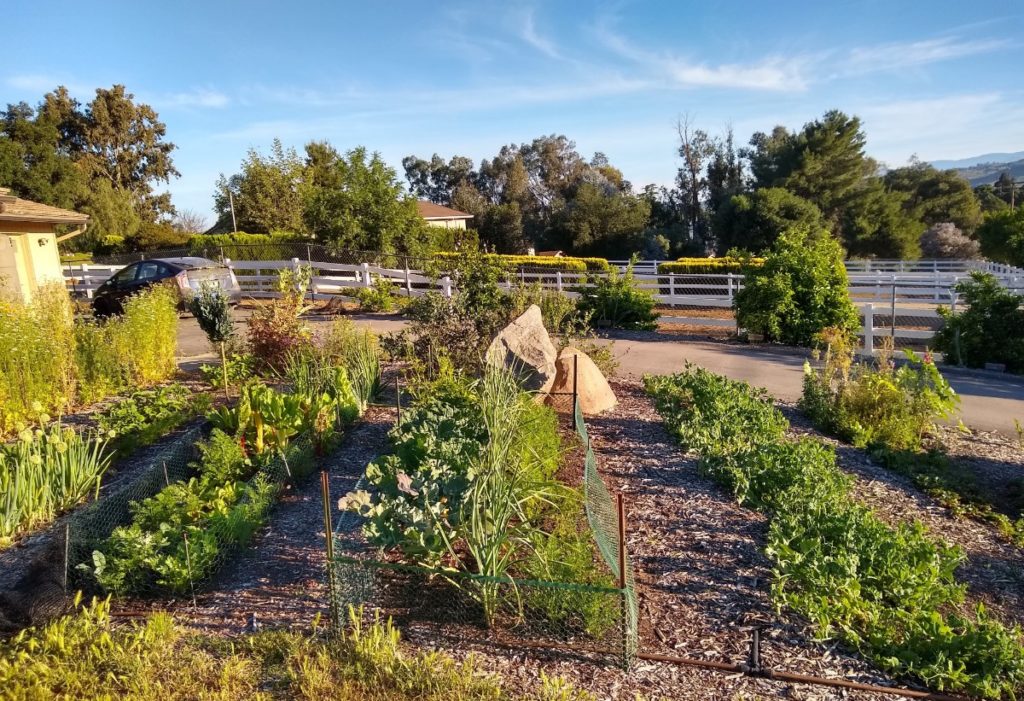
For a few years, I also watered both the blueberries and vegetables on drip lines.

They all performed acceptably, but I found that the blueberries sometimes looked parched in the heat of summer, as if they needed more water. At first, I added more drip emitters for the blueberries. Later, I switched to using sprayers on the blueberries instead of drip and the bushes seem to like that method of irrigation more.
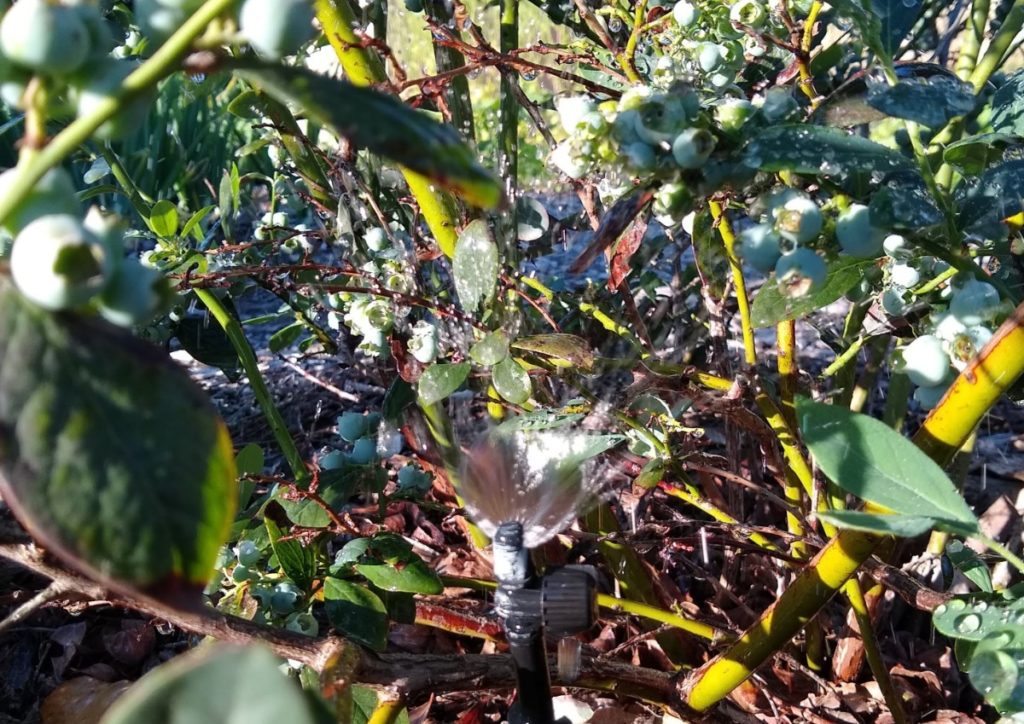
Moreover, the sprayers on the blueberries have tiny shutoff valves that allow me to adjust the water output. As the bushes grow, I can easily turn up the water volume.
These sprayers work fine on a line that also uses drip emitters because they both need about the same water pressure to function properly. Mixing these methods is a convenient way to get some plants on a line more or less water than others.
Sometimes I wish I were a farmer of a 100-acre monoculture of only tomatoes rather than what I am, a gardener of a slice-of-an-acre polyculture growing 100 different plants. The watering would be easier.
Yet by grouping these plants as much as possible according to their water needs — hydrozoning — we can make our gardening lives a little easier. And when hydrozoning isn’t possible or practical (maybe it’s too late because the plants are already in the ground), we can mix irrigation methods and we can add shutoff valves in order to give our fruit trees, berries, and vegetables approximately how much water each needs.

(You might like to read my post: “Growing blueberries in Southern California.”)
A list with links to all of my Yard Posts is HERE.

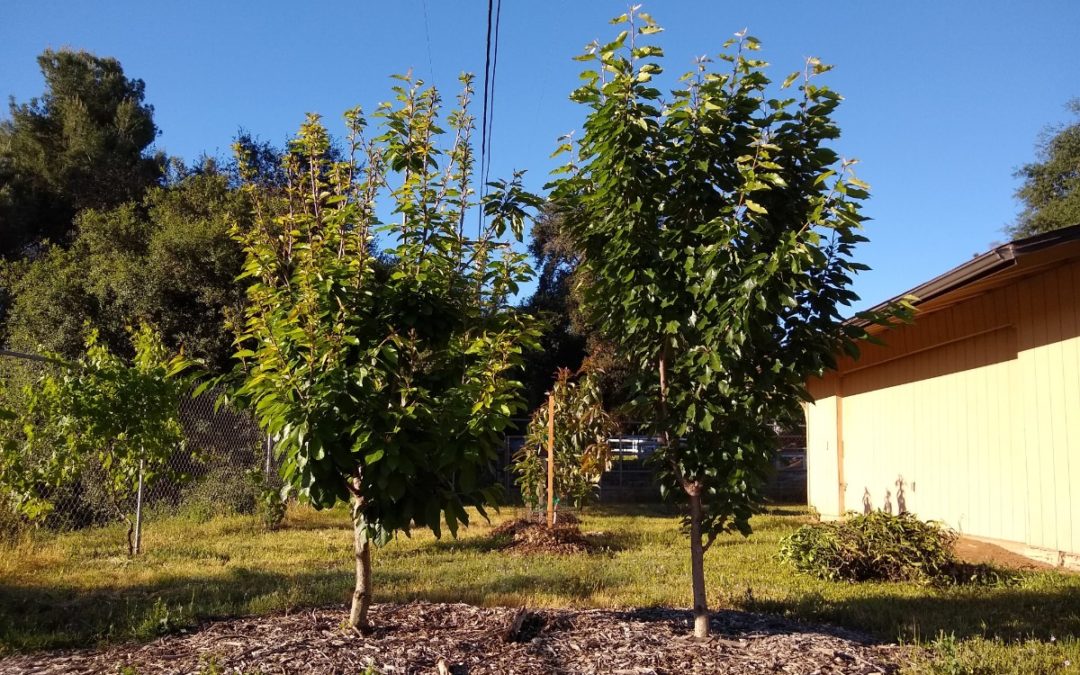


Hi Greg – Thanks for all the helpful posts. I just installed irrigation with 3 sprayers on each tree. It is mostly citrus, but also a 4-apple apple tree and a “fruit salad” tree along with the Spice Zee, thanks again for that. But I am still not sure how much to water them. Once or twice a week and for how long? I have had them on for 20 minutes at a time once a week.
Another couple of questions. My Oro Blanco was doing so great with so many blossoms and then all of the sudden it started dropping the blooms and the leaves. And my Cutie Tangerines leaves are curled in and it is not from bugs. Thanks in advance and be well – Steven
Hi Steven,
Thanks. I’ve just been reviewing how much water to give each of my trees. It’s that time of year!
First, read this post if you haven’t already: https://gregalder.com/yardposts/how-much-to-water-a-fruit-tree-in-southern-california-roughly/
Second, how to know how much water your sprinklers/sprayers are applying? Stick them in a bucket for ten minutes. Measure the gallons they put into the bucket. Multiply by six to get a gallons-per-hour rate.
Write this figure down somewhere so you don’t have to do it again next spring.
When citrus are thirsty their leaves make a taco shape. When they are drowning they often get yellow and even drop leaves. But always, citrus trees are somehow curling and flopping in various ways so it takes some consistent observation to get to know your particular tree/variety and its indicators.
Hi Greg – Thanks so much for that link. It’s perfect. Now to go out and put one of the bubblers into a bucket for 10 minutes. 🙂 I super appreciate your posts.
Best – Steven
I installed some micro sprayers and they’ve been doing awesome, no more hauling a sprinkler for hours! I saw some new products that are watering stakes for trees and shrubs that connect to irrigation lines, they advertise sending water straight to the rootball to minimize evaporation and improve growth… any thoughts? They are available at Home Depot and I was thinking of getting them to improve my trees.
Hi Alexander,
I’m familiar with those watering stakes although I’ve never used them. I’ve seen trees on them in places like parking lots and the trees are growing fine. Obviously, they work in terms of getting water to the trees, but I have no reason to think they are significantly more efficient than drip emitters (regarding evaporation), and I’d be surprised to find that they actually improve growth compared to drip or sprinklers since the upper level of the soil is where the most nutrients generally are, as that’s where the most organic matter and soil organisms are. I don’t know of any formal study comparing this deep watering method to other methods.
Greg, as usual, your article about hydrozoning is very important and a needed consideration especially for those planning their irrigation. My home has 3 irrigation valves and lines in the front of the house and 2 of those 3/4″ lines go up the side and to the back yard. Being on a hillside it would be very difficult to now install 2 more lines, so I’ve had to work with what is there. When I bought the house their were 2 fruit trees a lemon and a lime. Now I have over 150 that I never planned on having. I added a couple avocado trees and also added 1/2″ pvc to those trees. I became addicted to digging holes and planting new fruit trees and adding irrigation. I have a very small lot, but the more trees I added the more water flow was needed. I now have all trees with their own 1/2″ pvc riser with piping mostly underground and I use a dual head drip connector at each tree to feed 1/4″ poly line. To be able to maintain the water pressure I bought emitter tubing 12″ apart and create a large circle with each end connected to a TEE fitting and the TEE fitting connected to the water supply. It is placed under the bark mulch. This gives me enough water around the root ball to keep the tree alive. I’ve also added a sprayer to most of my trees as you show in your article for better control of the water used. My planning was mainly about picking a variety that I wanted and pollination (my pluots are close together), so I have a big mix of deciduous and citrus and avocado on only 2 lines. My only choice is to regulate the water at each tree using drip micro valves and that has been working fairly well.
My recommendation to those designing irrigation is to put in more lines then you think you will need for future expansion because digging tree roots out of the way and going under concrete is difficult later on. I keep most of my trees small to conserve water intake and because I don’t have the space to let them get too wide.
Also, I have 3 rain barrels – I use that water to hand water my blueberries since it has no calcium. It is an attempt to keep the soil acid.
I wish I had known about your hydrozoning concept 10 years ago – it would have changed where I placed many of my trees.
Wow, Richard, 150 trees on a small lot? It can’t be that small! Is it mostly hillside?
Your comments got me thinking. Most of our 1/4 acre lot is hillside with weeds, ivy and some kind a evergreen brush vying for territory. I have idly dreamed about planting the trees I would like to have (avocado and grapefruit) on the hillside, but have no idea if that is a pipe dream.
I have no way to water them (at present), and have been simply putting a hose on the lemon tree I planted in the flat space in the backyard. Every time I water it I have to run back and forth between the spigot and the end of the hose at the tree to get the slowest trickle possible out of the hose. Completely inefficient, I know.
I have gravel over black landscape cloth in this small backyard area, no drip hose, no irrigation line. But you have me thinking. I need to put in the work and learn how to add a drip line (yes, bass ackward since the landscape and gravel are already there), but it would save me time in the long run.
And if I could get that together, maybe I could begin thinking about the hillside. Thank you for sharing your experience!
Hi Kelly,
If you’d like to save time and effort this summer but sacrifice some beauty, you can very easily get some irrigation to the lemon (and up to future avocado and grapefruit trees) by using poly tube that connects to your faucet.
You’d need only four components: poly tube, hose-thread adapter, figure 8 or end cap, and the emitter (drip emitters or micro-sprinkler). All of these can be picked up at a good nursery or Home Depot or bought online.
You connect the hose-thread adapter to your faucet, the poly tube connects to the hose-thread adapter, and you lay the tube over the gravel to your lemon tree. Punch the emitters/sprinkler into the tube (you can use a nail or a purchased punch tool) near the tree and add the figure 8 or end cap at the end of the tube. Done.
It’s not so pretty, but in the winter when rains return and soften the soil under the gravel you can easily dig a small trench to bury the tube if you want it to “disappear.” I’ve done this type of thing many times in my yard.
Thank you for another great article!
I appreciate how you’re articles are timely at addressing current events. I think every year I continually try to dial in my irrigation. One way to address the imbalance of watering needs of trees on the same valve is to select or use differing flow rates. One reason I like using drip is that I feel I have more precise control.
Hi Justin,
Thanks. I’m also constantly trying out new things with my irrigation. Last year was the year of high frequency, where I irrigated far more often than in previous years but with no change in overall volume. It mostly worked fine. It came with a few disadvantages, such as lower distribution uniformity because I’m on a slope, but it mostly worked fine.
I also appreciate the precision that drip allows. For example, you can just add a single emitter to a line around a fruit tree and instantly know exactly how much more water you’re giving it. That is so convenient. I have started to migrate back to drip on some of my trees, and this is one major reason for it.
Hi Greg, just want to thank you for the info provided.
I followed your advice on micro valves before the emitters (either as being an integral part of the micro sprinkler/sprayer or separate ones), whatever there are, and it paid off.
So currently I have 14 avo trees (1year; 2year and 3years old) and others (sour cherry & mulberry) on one line and control the water flow through the micro valves from Antelco.
First measurements shows that adjustments give you a wide range of control; i.e. 90º sprayers at 4 g/h and 8 g/h.
Funny thing is if you don’t use a bucket with a volume scale, it’s difficult to understand how much you are watering, even for me being used in controlling stuff like leakage rates of industrial equipment.
Thanks,
Hi Vasco,
Great to hear that the adjustment valves are helping out. It’s convenient to be able to irrigate trees with different needs on one line.
Agree on the bucket difficulty. Sometimes I just guess and other times I dump the water from the bucket into another container that has a volume scale in order to measure.